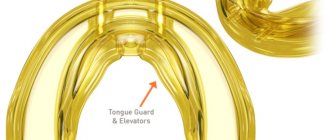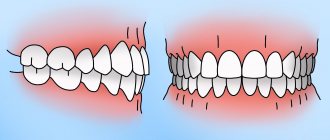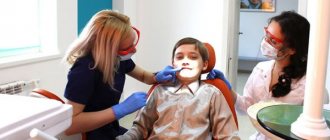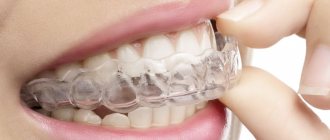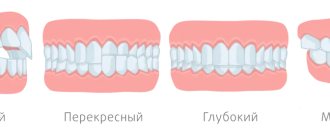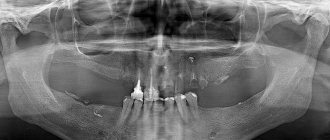Chief editor of the site:
Snitkovsky Arkady Alexandrovich
Chief physician of the professorial dentistry “22 Century”, dentist, orthopedic dentist
Author of the article:
Scientific team of dentistry “22 Century”
Dentists, candidates and doctors of medical sciences, professors
Identification of any signs indicating an inflammatory process or discomfort from fixed dentures is a reason to contact your doctor.
When to use
The plate is used for orthodontic treatment of children under 12 years of age. This removable device is effective during the period of change of baby teeth and intensive growth of bone tissue. While the formation of the dental system is not completed, the design can cope with the following tasks:
- teeth straightening;
- correction of abnormal bite;
- palate width correction;
- change in jaw position;
- getting rid of bad habits that affect the bite (if the child sucks his finger, bites his lip).
For adults, plates are recommended to consolidate the results of treatment after removing braces (they fix the dentition in the correct position and prevent the teeth from “returning” to their place).
Price
The dentist will be able to indicate the exact cost of the plate only after a thorough diagnosis.
If you decide to buy a dental plate, the price will depend on its type, the material used, the complexity of manufacturing, the number of plates, the presence of screws, springs and other additional accessories. The location of the clinic and its prestige, as well as the qualifications of the medical staff, play an important role in determining the cost.
A removable orthodontic plate for teeth will cost less (8-20 thousand rubles), but it will have to be replaced several times, which will significantly increase the total cost.
If it is necessary to place a permanent plate on the teeth, the price will reach 30-90 thousand rubles.
Bite correction
The most common indication for the use of leveling plates is an abnormal primary or mixed bite. This appointment is justified, because with such a bite, the position of the teeth is quite easy to correct and does not require a large load.
If the plate is placed under excessive pressure, there is a risk of losing a baby tooth. Therefore, the dentist must supervise the installation of the plates
Content:
* For detailed information about the conditions of the promotion, please contact the clinic administrator.
Dental plates for children are removable dental structures used to straighten teeth in children. This type of orthodontic treatment of malocclusion is especially often used in preschool children.
Note to parents: Moms and dads, remember that although modern orthodontic dentistry can successfully combat crooked teeth, it is in childhood that teeth straightening is treated most successfully and quickly. Take your child to see a pediatric dentist regularly and do not delay treatment.
Since each such plate is made individually for each child, this allows its shape to be adjusted as accurately as possible to the dentition, which, in turn, reduces the inconvenience of wearing it. As we noted above, dental plates are removable structures, i.e. so that they do not interfere, they can be removed, for example, while eating or brushing your teeth.
Peculiarities
Alignment plates, also called retainers or braces, are used to correct a child's misaligned bite as it begins to develop. They are recommended for isolated pathologies, and are also prescribed after the use of braces to consolidate their effect.
Individual models of plates differ in their structure, but all such orthodontic devices have the same basic elements - a plate, a wire (arc) and a fastener. For the plate itself, soft or medium-hard plastic of different colors is used. It is curved according to the shape of the child's palate. The main function of such plastic is to hold an arc made of titanium-nickel alloy.
It continuously affects the incorrectly positioned crowns of the teeth and causes them to gradually shift. And since the force of impact is not too great, the arc does not harm the root system of the teeth. The thickness of the wire may vary depending on the situation.
Plates will help cope with improperly growing teeth when the bite is just forming
Why does discomfort occur?
This orthodontic device is made individually based on a cast of the dental arch and palate, which allows it to accurately replicate the anatomical characteristics of a person. This technology is necessary to ensure that the patient experiences minimal discomfort during orthodontic treatment. Despite this, in the first days a whole list of unpleasant sensations often arises. To understand what causes it, you need to know the structure of the plate.
Its base is made of inert plastic, which fits closely to the hard palate of the lower or upper jaw. The base is not very thick, but even these few millimeters are enough to place the tongue inside the oral cavity in an unusual position. Even at rest, the new position does not correspond to the usual one. If special expanders are installed in the palatal part, the lack of space becomes even more pronounced.
The second element of the system are metal hooks and staples. They pass from the inside to the vestibular part of the teeth. The inner part of the lips and the mucous membrane in this area are penetrated by a large number of sensitive cells, and its hyperstimulation by new elements causes discomfort.
Indications
Plates are prescribed for:
- Displacement of one tooth.
- Incorrect placement of several teeth.
- Rare arrangement of dental crowns.
- Problems with the development of the jaw bones.
- Slowing or increasing jaw growth.
- Narrowing of the palate.
- Desire to prevent tooth movement after using braces.
Watch the following video about teeth straightening plates.
Leveling plates are not used if the child has:
- Periodontitis has developed.
- You are allergic to the components from which the device is made.
- There are respiratory tract diseases.
- There are teeth affected by caries.
How to speed up the addiction process
To get used to it as quickly as possible, you need to strive to wear the plate as long as possible, without giving in to the urge to remove it. In this case, the habit will develop much earlier. Many questions are related to how to get children not to remove the system at the time of addiction. This is very important, since constant filming can not only lengthen the adaptation process, but also completely eliminate all efforts.
For young children, it is recommended to make bright colored plates that the child may like with their appearance. Parents can come up with a fairy tale about this bright little thing that will interest the baby and make him warm up to it.
You need to be frank with teenagers and explain how important it is not to remove the plate and what results can be obtained at the end of the orthodontic course. If necessary, you can show before and after photos, since a visual example works much better than any words.
Operating principle of the plate
The dental plate consists of a titanium-nickel arch and a plastic base with clasps (hooks) along the edges. The principle of operation is to apply constant pressure to the dentition, as a result of which the bite is corrected and the teeth are aligned. The arc presses, and the intensity of its influence is regulated by a screw built into the plastic part (when the screw is tightened, the base expands).
The pressure is moderate, so the plates do not harm the roots and give them the opportunity to gradually rebuild. The arc is able to return to its original shape regardless of how the plate is deformed.
Even if the structure is broken, it can always be repaired. To do this, it is enough to take her to the orthodontist. In case of simple breakdowns, the doctor will repair the plate right at the appointment. Sometimes the repair takes one or two days and is carried out in a dental laboratory.
Methods for restoring a broken front tooth
What to do if your front tooth is broken? The specific restoration method is chosen by the dentist, taking into account the type of fracture, the amount of damage and other factors. The direct method involves restoration directly in the patient's mouth. This usually only requires one visit to the dentist. In this case, various composite materials are used that completely match the color of neighboring tissues, so the intervention of a specialist will not be noticeable.
| Pros of the direct method | Disadvantages of the direct method |
|
|
During indirect restoration, missing parts are replaced with prefabricated prostheses. This technique allows you to restore large defects, for example, when a large piece of a front tooth has broken off. Most often, the doctor uses the following types of prostheses:
- Veneers. They are thin plates that are matched to the color of the tooth. Veneers have different thicknesses and can be installed both with enamel turning and without turning (Hollywood veneers). Strong cement is used for fixation. Veneers are suitable for repairing small chips in enamel, but they do not correct the defect itself. This method can only hide a broken front tooth.
- Crowns. One of the most popular types of prostheses that have been used in dentistry for a long time. A crown is placed on a broken front tooth in cases where the amount of damage is very large and a significant part of it is missing. Crowns are made from various materials: metal, ceramics, metal-ceramics, zirconium dioxide, etc. The best option in terms of price/quality ratio is metal-ceramics, and for patients who need the most aesthetic result, ceramics and zirconium dioxide are perfect. The crown can be fixed to a previously prepared stump or an installed pin (implant).
- Bridge. This type of prosthesis is obtained by soldering together several single crowns. In order to install it, it is necessary to prepare one tooth on both sides of the defect. Thus, if a patient has two broken front teeth, the bridge will consist of four crowns. It is also possible to make a prosthesis from three crowns per tooth, which is used more often.
Among the advantages of the indirect method are the ability to restore extensive damage, good aesthetic results, and high resistance to heavy loads. The disadvantages will be the high cost of the technique, the need for preparation, and in some cases, depulpation of the tooth, and the impossibility of correcting the defect in one day.
Installation process
- The production of the plate must be strictly individual. First, the child is examined by an orthodontist to identify problems, and also sends the little patient for an x-ray. Based on the examination, the doctor selects the type of plate and tells the patient and his parents about the principles of operation of the device.
- After taking a wax impression of the child's teeth, it is used to create a plaster model, on the basis of which a plate is made. The second visit to the doctor involves installation and adjustment of the structure, which takes approximately 10 minutes.
- Next, the doctor will inform the parents about the specifics of care, the need to adjust the arch (if provided), as well as the duration of use of the plates. On average, such a device is worn for about 2 years. If the device is removable, it is recommended to wear it at least 21 hours a day, removing it only for brushing teeth and eating.
The plates are made individually for each child based on an impression
Causes of complications after fixed prosthetics
Errors in diagnosis and planning of orthopedic treatment
Errors in diagnosing and planning orthopedic treatment
Perhaps the most important and most difficult stage of orthopedic treatment is planning and choice of design. An incompletely studied medical history, insufficient X-ray examinations and incorrect interpretation of images, an inattentive approach to the patient’s complaints. All this today is a gross mistake by the doctor.
Mistakes when preparing the oral cavity for prosthetics
Before orthopedic treatment, it is necessary to carry out sanitation of the oral cavity: professional oral hygiene, removal of severely damaged teeth that cannot be properly restored with fillings or inlays, therapeutic treatment of teeth necessary according to indications, and soft tissue and bone grafting is also possible. Errors in preparation can be detected after prosthetics, so a very careful approach of all doctors is necessary.
Errors in the clinical stages of prosthetics
Orthopedic treatment usually consists of several stages. Making a mistake at any of the medical stages can lead to adverse consequences. The most common medical errors in permanent prosthetics include incorrect preparation of teeth , inaccurately taken impressions, incorrect bite determination, incorrect fitting of frames, non-compliance with the rules when installing a prosthesis, as well as non-compliance with the stages of prosthetics.
Errors in technical stages of prosthetics
Half the success of proper orthopedic treatment depends on the dental technician. Failure to comply with certain rules for the manufacture of dentures leads to further complications. Most often, these are errors in the inaccurate production of plaster models, poor casting of frames, and incorrect modeling of the cutting or chewing surface of the teeth by a dental technician.
Caring for records for children
The dental plate must be removed when eating or playing sports. Parents should monitor how much time the child spends in the plate, how often and how well he cleans it.
Cleaning the plate with a regular toothbrush
Cleaning
Plates need to be cleaned as often as teeth. It is recommended to use soft brushes and special cleaning gels. The plate should be disinfected weekly by leaving it in a container with liquid overnight.
How to twist?
To ensure gradual alignment, you may be required to tighten the plate regularly using a wrench provided by your dentist.
The key is inserted into the hole in the screw and turned forward in the direction indicated on the plate. One movement - one full revolution. To cancel the action, turn the key back.
Although the leveling plates are made from flexible plastic and hardened metal, failure to properly care for the device can cause it to break. Here's how to care for your braces:
- Clean the plate daily (at least once) with a soft toothbrush and regular toothpaste or special gel.
- The staples are treated weekly with a solution that provides deep disinfection. To do this, the plate is placed in the solution overnight.
- The plate should be removed before each meal.
- Before each installation, the plate is washed with warm boiled water.
- A special container is used to store the structure.
- If the plate breaks, it should be taken to a doctor immediately.
- To prevent the rotary screw from jamming, it is recommended to lubricate it with a drop of oil.
How to wear dental plates - recommendations for children and parents
Whether dental plates help is the main concern of parents. Much depends on how correctly the young patient wears the orthodontic apparatus.
The main requirements for wearing orthodontic plates:
- duration – up to 20-22 hours daily;
- care - morning and evening cleansing with pastes, gels, weekly deep cleansing in a special solution;
- remove the product when eating;
- Do not play with the orthodontic appliance - remove it and return it to its place in the mouth with your tongue.
The doctor will show you how to put the plate on your teeth at your appointment, but there is nothing complicated about it. Metal arches fix the structure, and the regulatory elements are responsible for gentle correction of the bite while wearing.
It happens that a child takes the product out of his mouth, and then cannot figure out how to put the plate on his teeth - it either falls off or does not fit into place. Such a circumstance may be preceded by the following events:
- the device was in the mouth for less than 12-14 hours a day, and the fixation was broken;
- supporting units have been removed or fallen out – the structure requires orthodontic correction;
- a tooth erupts under the polymer part of the system and prevents it from taking the correct position;
- the plate was not worn for several days in a row - the bite has returned to its original position and you need to see a doctor to adjust the device;
- violation of medical recommendations for wearing removable plates - it is worth coming to an appointment and checking the condition of the product.

